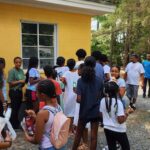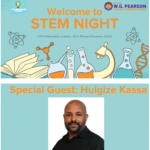This summer, the MAAQEF Summer STEM Program brought together young learners from grades 1 through high school for a seven-week journey of exploration, problem-solving, and creative expression. Guided by passionate instructors and guest experts from our community, students engaged in activities that blended science, technology, engineering, and mathematics with real-world applications and plenty of hands-on fun.

Week 1 began with group assignments and an introduction to our learning spaces: Group I (grades 1–3) gathered in the Yellow House, while Group II students met in the Trailer (grades 4–7) or Green House (grades 8+). Younger students dove right into hands-on science with colorful DIY lava lamps to explore density and chemistry, followed by baking soda volcanoes that erupted in dramatic demonstrations of chemical reactions. Meanwhile, older students tackled advanced topics in CNC technology and digital manufacturing. They learned to design in Tinkercad, export STL files, and use CAM software to prepare designs for CNC machines. In a parallel track, another session on UX/UI design introduced students to user experience principles, with hands-on practice building intuitive digital interfaces using Figma.

In Week 2, we adapted to internet connectivity challenges by equipping students with offline design tools that would ensure uninterrupted creativity. FreeCAD provided a powerful platform for 3D modeling, while Lunacy offered a feature-rich environment for graphic and interface design—both without the need for online logins. Students installed these tools and began integrating them into their projects.
Week 3 brought an exciting blend of technology and life sciences. Group II explored the world of databases in a session led by a Senior Cybersecurity and Lead Database Engineer from our community. Using DBeaver, students learned the fundamentals of storing, organizing, and retrieving data in a hands-on, age-appropriate way. The second half of their day took them into veterinary science, where a clinical veterinarian and the Head of a Veterinary Diagnostic Lab introduced diagnostic tools, lab techniques, and the role of technology in animal health. Group I spent the week engineering marble runs and enhancing them through iteration, before switching gears to a lively math game that used number lines, dice rolls, and quick problem-solving to reinforce arithmetic skills in an engaging way.

By Week 4, financial literacy and electrical engineering took center stage. Group I participated in a life-sized version of Monopoly, navigating the responsibilities of budgeting, decision-making, and resource management in a fun and interactive format. Group II balanced two complementary learning experiences: an introduction to electricity and circuit design, where students worked with components and wiring to understand how electrical systems function, and a beginner-friendly dive into money management, covering budgeting, saving, and the basics of financial planning.

Week 5 continued the mix of creativity and technical skills. Group I revisited one of last year’s favorite STEM projects—building windmill generators—as a way to explore renewable energy concepts. They also tested parachutes made from coffee filters, experimenting with wind resistance and learning how design impacts performance. Group II deepened their understanding of electronics with more circuit design projects and expanded their knowledge of personal finance through interactive lessons on budgeting and responsible spending.
Week 6 pushed the boundaries of innovation even further. Group I refined their windmill generator builds while taking on other playful STEM challenges. Group II turned to coding and data analysis, starting with Arduino projects that combined programming with circuitry to create functional prototypes. They then explored data visualization using Tableau, transforming real datasets—from Spotify streaming history to video game sales—into compelling visual stories that revealed patterns and insights.
The program wrapped up in Week 7 with a balance of celebration and skill-building. Group I continued their creative projects and returned to the lively Monopoly game, applying the decision-making and budgeting skills they had practiced earlier in the summer. Group II completed their Arduino projects, fine-tuning their designs and code. All students came together for a special lifesaving skills workshop led by a professional paramedic, learning essential first aid and emergency response techniques in an interactive, hands-on format.
Over the course of these seven weeks, our students learned not only how to use cutting-edge tools and scientific methods, but also how to collaborate, think critically, and approach challenges with curiosity. The MAAQEF Summer STEM Program continues to be a space where young people can explore their interests, discover new passions, and gain the confidence to innovate. We are proud of everything our 2025 participants achieved—and we can’t wait to see the impact they will make in the years ahead.



